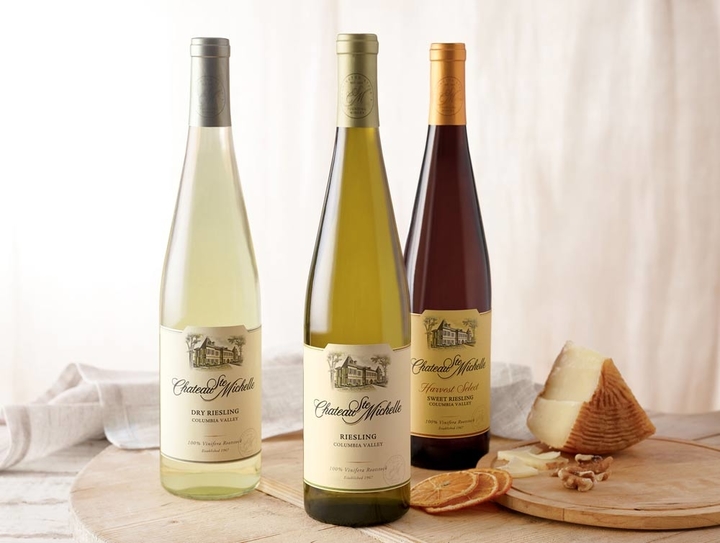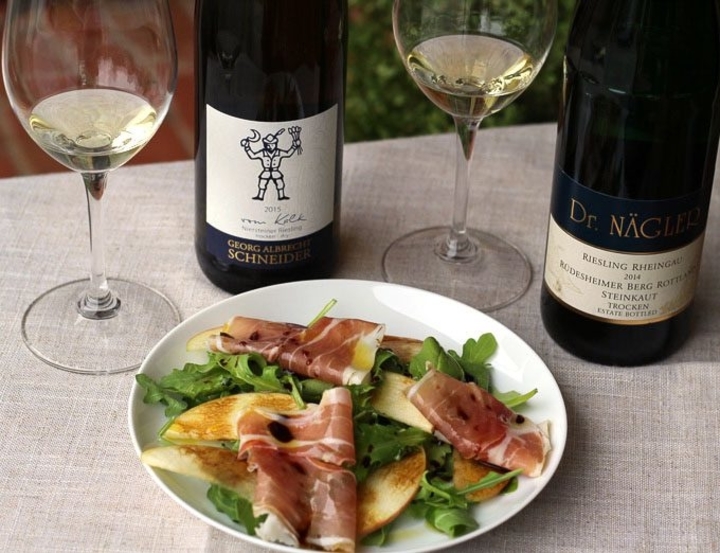Riesling is one of the most diverse and popular white wine varieties on the market. Thanks to its wide range of flavours, rieslings are easy to match with a variety of dinner dishes, making them a loyal crowd pleaser. But not all rieslings are alike, as some have pretty distinct characteristics and flavours. Explore the different styles of riesling wines so that you can better understand what you should look for when purchasing this fine grape wine.
Sweet or Dry Riesling?

Most people agree that riesling is an aromatic grape, meaning that its wines are intensely flavoured and expressive. The flavour profile of a given riesling depends on where it was grown. Different regions produce different styles.
Sweet Rieslings
These are made from grapes harvested late in the season and usually include some portion of raisined grapes. The wines are sweet and often have aromas of rose petals, honey or lychee nuts. They tend to be full-bodied with high acidity, which balances the sweetness. Sweet riesling white wine is fruity and floral, tasting like honeyed apricots or peaches — or even grapefruit and orange marmalade — with hints of gingerbread and pine resin. They have a syrupy texture that coats the palate and balances out the sweetness in desserts (or foie gras).
Dry Rieslings
Dry rieslings can be pretty complex, which is why they’re popular among serious wine drinkers. It’s not uncommon for them to have aromas of honey, citrus or peaches; flavours of apples or pears; and good acidity. Dry riesling white wine tends to taste like lime, minerals and honey. They’re not fruity. They’re light-bodied wines that feel fresh and clean in the mouth, with a crisp acidity that makes them great with spicy food. Their intense mineral flavours can also pair nicely with Asian dishes.
Different Types of Riesling

The best Rieslings are produced from grapes harvested late in the season when they have reached a high level of ripeness that balances their natural acidity. With flavours of ripe apples and apricots, these wines show a range of sweetness levels, which are used to classify the different types:
Eiswein 300+ g/l Aromatic
Aromatic varieties include Gewürztraminer and Muscat. They’re “aromatic” because they have a strong floral, perfume-like fragrance and flavour. These wines tend to be more full-bodied than other Rieslings, which means they make good dessert wines.
Non-Aromatic
The classic German riesling and other popular white wine grapes such as Chardonnay and Sauvignon Blanc are in this group. These varieties have a lighter body and lower alcohol content than the aromatic Rieslings. This type of riesling goes well with foods heavy on spices or herbs since these wines often have notes of citrus fruits and mineral tastes.
Hybrid
Hybrid varieties are crosses between Vitis vinifera (the classic grapevine species) and American species such as Vitis labrusca or Vitis Riparia. Unlike European grapes, hybrids can tolerate colder temperatures and resist certain viruses that affect grapevines in the U.S., Canada, Australia and New Zealand. Hybrids tend to be sweeter than non-aromatic varieties, making them suitable for dessert wines.
Its different styles also make it very versatile. A glass of dry Riesling is a great way to start a meal, while sweet Riesling is perfect with dessert or on its own as an after-dinner drink. And if you’re looking for something to pair with spicy food, look no further — Riesling is made for it.
Food Combinations

Riesling is a great wine to use when you’re new to food and wine pairing because it’s so versatile, and it’s always a good idea to start with what you know! Riesling tends to be sweet on the palate, but it can vary from bone dry up to syrupy. It pairs well with rich foods, salty foods, spicy foods, and desserts! Here are some suggestions for Riesling food combinations:
Thanks to their complementary flavours, riesling and seafood have been considered an excellent match for hundreds of years. This grape variety is often thought to have a delicate flavour profile that makes it ideal for white fish like trout, salmon, and sea bass.
Cheese & fruit platter. When you’re serving a cheese plate with milder cheeses like brie and Camembert, go with organic white Riesling wine. The sweetness will balance out the creaminess and saltiness of the cheese, while the acidity will help cut through it. Sweet fruits like figs and apricots are also great complements to riesling’s fruit flavours, making this pairing ideal as an appetizer or dessert.
Dry Rieslings are great with Asian cuisine, especially Chinese and Thai food. Spicy Szechuan dishes with chile peppers, garlic, ginger and soy sauce are enhanced by the crisp, refreshing taste of dry riesling.
Pork is one of the most popular meats to pair with Riesling wines. Their light and fruity flavours complement pork dishes that feature cream sauce or fruit sauce such as apricot sauce or apple sauce. Chicken is another meat that pairs well with Riesling wines because they don’t overpower its mild flavour.
To Sum Up
Riesling is surprisingly versatile, pairing perfectly with sweet seafood desserts and excelling as an aperitif. In the end, it’s just a matter of finding your comfort zone within the sub-categories and then selecting wines that suit your tastes. If you are looking to explore the world of German wine by learning more about riesling, we hope you’ll find this guide helpful on your journey!